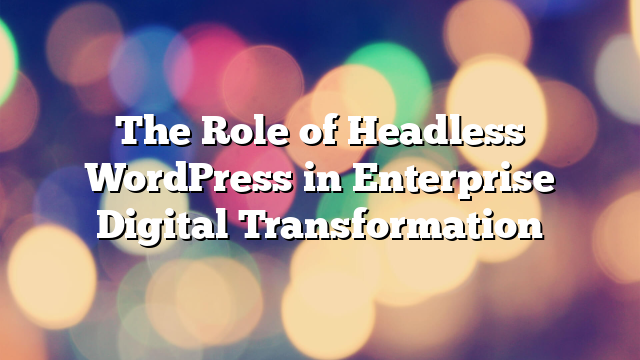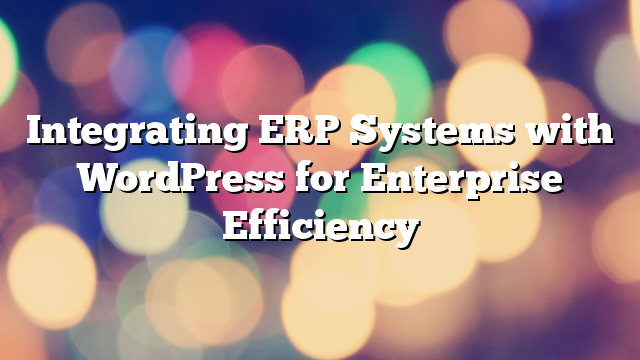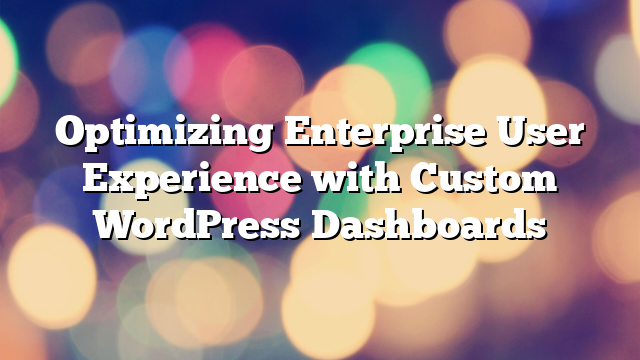The Role of Headless WordPress in Enterprise Digital Transformation
23.11.2024

Digital transformation is at the heart of modern enterprise growth. As businesses evolve, their digital platforms must adapt to meet new demands for scalability, flexibility, and innovation. Headless WordPress has emerged as a powerful solution for enterprises embarking on this transformation journey. By decoupling the front-end and back-end, Headless WordPress enables unparalleled customization, omnichannel content delivery, and seamless integration with advanced technologies. In this article, we’ll delve into how Headless WordPress drives enterprise digital transformation.
What is Headless WordPress?
Headless WordPress separates the back-end content management system (CMS) from the front-end presentation layer. While traditional WordPress handles both aspects, the headless approach allows developers to use WordPress for content management while delivering that content through APIs to any front-end framework, such as React, Vue.js, or Angular.
This decoupled architecture provides unmatched flexibility, making it ideal for enterprises with complex digital needs, such as omnichannel content delivery and rapid development cycles.
Why Enterprises Choose Headless WordPress
1. Omnichannel Content Delivery
In the digital-first era, enterprises need to reach customers across various platforms, including websites, mobile apps, IoT devices, and social media. Headless WordPress enables seamless content distribution to all these channels via REST or GraphQL APIs, ensuring consistent messaging and branding.
2. Enhanced Performance
Headless WordPress improves website performance by allowing developers to use modern JavaScript frameworks for the front end. These frameworks enable faster load times, smoother user experiences, and better scalability, crucial for enterprises handling high traffic volumes.
3. Flexibility and Customization
By decoupling the back-end and front-end, enterprises can build fully customized user interfaces without being constrained by WordPress themes. This flexibility is ideal for businesses aiming to create unique digital experiences tailored to their audiences.
4. Better Integration with Enterprise Systems
Enterprises often rely on a variety of systems, including CRMs, ERPs, and analytics platforms. Headless WordPress makes it easier to integrate with these tools using APIs, creating a cohesive digital ecosystem that enhances efficiency and decision-making.
5. Future-Proof Architecture
The technology landscape evolves rapidly, and enterprises must stay ahead. Headless WordPress provides a future-proof architecture that supports emerging technologies like AR/VR, voice assistants, and AI-driven personalization, ensuring businesses remain competitive.
Key Features of Headless WordPress for Enterprises
1. API-First Approach
Headless WordPress prioritizes APIs, enabling seamless data exchange between the back-end and various front-end platforms. This API-first approach is essential for building scalable and flexible digital solutions.
2. Scalability
Headless WordPress can handle massive amounts of traffic and data, making it ideal for enterprises with large-scale digital operations. Its ability to integrate with CDN services further enhances scalability and performance.
3. Multi-Channel Publishing
With Headless WordPress, enterprises can create content once and distribute it across multiple channels. This streamlines content workflows and ensures consistency across platforms.
4. Improved Security
Decoupling the front-end reduces vulnerabilities by limiting direct access to the back-end. Enterprises can implement additional security measures, such as token-based authentication, to safeguard sensitive data.
Challenges of Headless WordPress
1. Increased Complexity
While Headless WordPress offers flexibility, it requires advanced development skills to implement and maintain. Enterprises must invest in skilled developers and robust technical infrastructure.
2. Higher Initial Costs
The customization and advanced technology associated with Headless WordPress can lead to higher upfront costs. However, the long-term benefits often outweigh these initial investments.
3. Limited Native Features
Headless WordPress sacrifices some native features, such as the built-in WYSIWYG editor. Enterprises must adopt new workflows and tools to manage content effectively in a decoupled setup.
Best Practices for Implementing Headless WordPress
1. Define Clear Goals
Before transitioning to Headless WordPress, enterprises should define their objectives, such as improving performance, enabling omnichannel delivery, or enhancing customization. Clear goals ensure the project stays focused and delivers value.
2. Choose the Right Front-End Framework
Select a front-end framework that aligns with your business needs and development capabilities. Popular options include React, Vue.js, and Angular, each offering unique strengths for building dynamic user experiences.
3. Optimize API Usage
Efficient API usage is critical for performance. Enterprises should implement caching strategies, minimize redundant API calls, and use tools like GraphQL for streamlined data queries.
4. Invest in Developer Training
Transitioning to Headless WordPress requires a skilled development team. Enterprises should invest in training and resources to ensure their teams can fully leverage the platform’s capabilities.
5. Monitor and Optimize
Continuous monitoring is essential to maintain performance and security. Use analytics and monitoring tools to track key metrics, identify issues, and implement improvements over time.
Conclusion
Headless WordPress is a cornerstone of enterprise digital transformation, enabling businesses to create flexible, scalable, and future-ready digital platforms. While the transition requires careful planning and investment, the benefits far outweigh the challenges, positioning enterprises for success in an ever-evolving digital landscape.
Ready to elevate your digital strategy with Headless WordPress? Contact AllWebDev to unlock the full potential of your enterprise website.



